A variety of small diesel engines have been fitted in Flicka sailboats. The most common is the Yanmar 1gm 10. This is a single cylinder engine with a reputation for durability and reliability. Other Flickas have been powered by Vetus, BMW, Beta and Ferryman. These engines are usually between 9 and 13 horse power.
The Yanmar 1gm 10 was the chosen engine for the Pacific Seacraft Flickas and the original engines are still running in many of these boats. It's not uncommon for a well maintained 30 year old 1gm to still be puttering away happily down below.
Yanmar has a huge global network and parts are readily available in most ports. The Yanmar 1gm 10 is very simple and can be repaired and maintained by any careful amateur. More about the Yanmar 1gm 10.
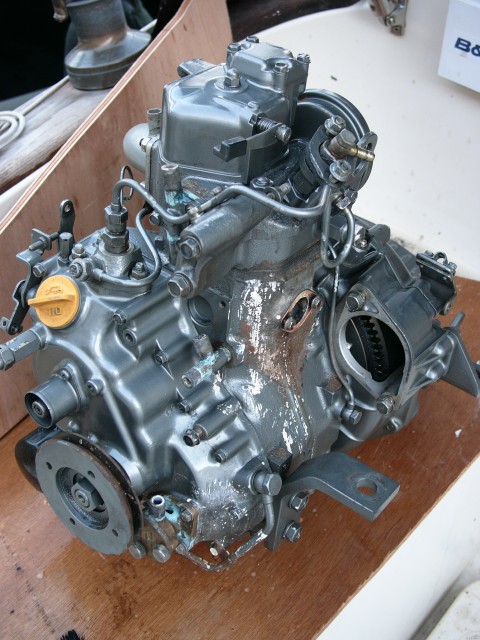
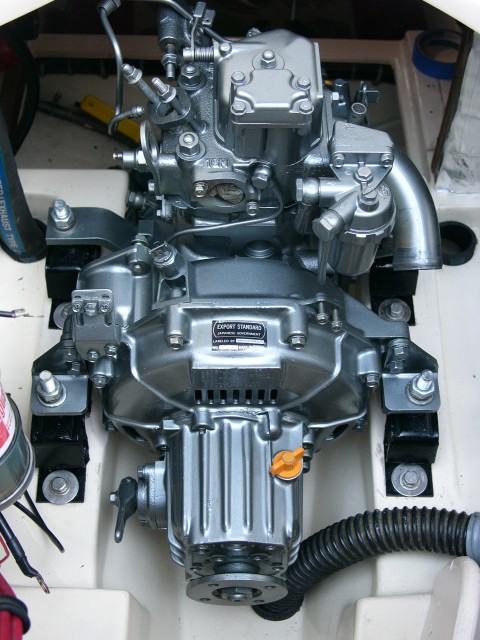
Improving the Yanmar 1gm 10 engine Installation or using an alternative
Flicka owners have made various improvements to their inboard installations such as fitting advanced alternator management systems, sound proofing and flexible couplings. Several Flicka owners now have feathering or folding propellors. One forward-thinking Flicka owner has even installed an electric motor in his boat, providing simple, clean and quiet motoring.
More about the 1gm 10
The Yanmar 1gm has been around since the late 1970's and is still available almost unchanged in design. The 1gm was modified slighty and became the 1gm 10 with a slightly larger fly wheel for more power. But the dimensions are almost the same.
Yanmar 1gm 10 specifications (.pdf)
Recently this engine has received some serious competition with the introduction of smoother and quieter 2 cylinder models of similar size. The new two cylinder Nanni 2.10 has been designed as a drop-in replacement for the 1gm 10. There are also several other engines on the market that would be a good alternative. These are in the 10 to 14hp range from Beta and Vetus and are Kubota and Mitsubishi based. However, the Yanmar 1gm 10 is still the smallest and lightest available.The Competition
The Nanni 2.10 looks like a really good alternative because, according to Nanni, it's a direct replacement for the 1gm 10. It's smoother and quieter and it's max revs are 3000 rpm. So it will reach hull speed at much lower revs leading to quieter motoring. It's heavier than the Yanmar but Nanni have made the dimensions almost identical, even the feet. In theory you can take out your old engine and stick this one straight in. If only it were that simple! Nagging doubts persist such as: Is the exhaust on the same side? Will it take my existing Balmar alternator.? Clearly, more research is needed here.
The Nanni 2.10 specifications (.pdf)
From Vetus the M 2.C5 or perhaps the M 2.D5 are worth a good look.
The Beta engines are 10 and 14 horse power and like the Nanni's are Kubota based. These are assembled in the UK. Beta will supply with Balmar alternators and regulators fitted and they also provide optional engine mounted oil pumps.
Beta 10hp specifications (.pdf)
Beta 14hp specifications (.pdf)
I like the customer testimonial on the Beta US web site. It says "what a concept, it is engineered to be serviced easily!". Well that would make a change..
The advantages of the 1gm 10
- The lightest and most compact marine inboard engine around.
- Proven reliability. A very simple and tough engine that when properly maintained and supplied with clean fuel and water will never let you down.
-
Relatively cheap to maintain and run. A 1gm 10 uses about 1 litre per hour at 2600 RPM. This rises to about 1 and 3/4 litres at 3000 RPM
Yanmar fuel consumption curve.
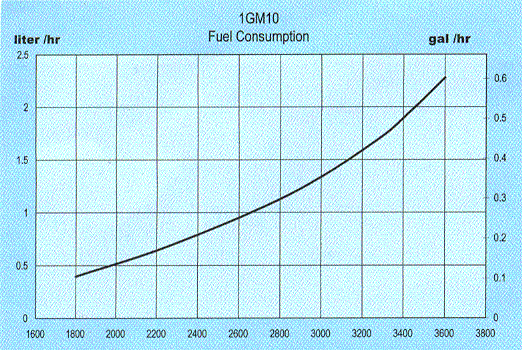
- Spares are easy to come by. The Yanmar network is worldwide.
- If something does go wrong there is nearly always a Yanmar specialist around. Or any reasonable mechanic will understand the engine and be able to fix it. It only has one cylinder so there is less to go wrong.
- Raw water cooling can be an advantage because its simpler; there is only one water pump and the cooling system is very basic. Thermostat and cooling system are easy to check and replace.
The disadvantages of this engine are for me as follows.
- Replacing the engine oil and filter every hundred hours can mean twice in one season when cruising in the Mediterranean.
- Replacing the engine oil and filter is a horrid job on a standard engine. The filter is horizontal and impossible to remove without spillage. Even if you fit a sump pump as I have done you still get in a mess with the oil filter.
- Replacing the gearbox oil requires a pump as there is no sump nut. So, even though I have fitted a pump to remove the engine oil I need another pump to remove the gearbox oil! Why didn't the engineers consider this problem?
-
The seals on the raw water pump are forever failing and the pump requires overhaul at least every season in the med. (this may be due to higher salt/particle content in the water??) I don't know and nobody seems to be able to tell me why. I have two raw water pumps and one is only a year old. I have a serviced one ready to fit at all times. When the pump seals fail the water drips onto an oil pipe beneath which causes corrosion. The metal springs on the pump seals rust! Yes, they rust! No wonder they only last a season. (Stripped down raw water pump from a Yanmar 1gm 10. Note the Speed Seal impellor cover which enables easier impellor replacement.)
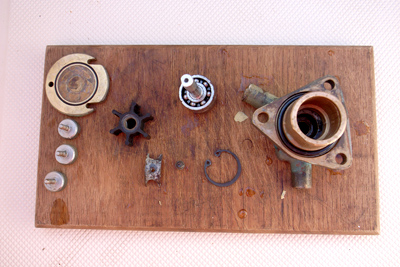
-
The engine anode is difficult to replace without removing either the starter motor or alternator! Plus the anode cover always leaks because as the anode corrodes the gasket on the anode bolt becomes ineffective. The anode itself screws into the cover forming a gasket. As it errodes the gasket fails. When sea water leaks down the side of the engine it causes corrosion. See pic below:
Rust around engine anode on Yanmar 1gm 10
(nb: I have lagged on some paint on the rusty areas to arrest corrosion. Alternator and starter motor are removed.)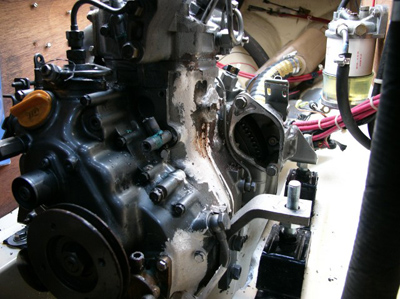
- The exhaust elbow requires regular inspection. Hot raw water is pumped into the elbow after it exits the engine and is mixed with the exhaust gases before being expelled. In the exhaust elbow there is a thin metal membrane. If this membrane corrodes through then the raw water can get into the cylinder head and damage the engine. Engineers Cellar Marine in Cornwall advised me to take the elbow off every winter and store it in a bucket of fresh water to stop corrosion. Mine was already pitted so I had to buy a new one. It was only £180! They are not cheap and it would be prudent to check every couple of seasons if not every season. Don't forget to buy a new gasket when you take it off. It's possible to remove the elbow and replace it without a new gasket but it's not worthe risk of a leak. It might be worth having a bronze elbow made up as my friend did on his wooden yacht where there wasn't enough space for the standard elbow. Bronze should last longer than the Yanmar supplied one and since the Yanmar ones aint' cheap you might get a custom bronze one for somewhere near the Yanmar price.
- The engine mounts. These were about £70 each to buy from Yanmar (in 2006). At that price you might expect they are properly painted because they are made from steel. The paint comes off in a matter of weeks and they go very rusty. If your engine room is damp (whose isn't?) good luck! Before installing I'd recommend giving them several coats of good quality paint. I've had the argument with several 'engineers' about what I consider to be their excessive cost. The engineers argument is that they are difficult to make and are high quality and last for years. I disagree strongly and believe Yanmar can do better. For example, a single shoddy Yanmar 1gm engine mount costs £70. A small Lie- Nielson bronze block plane; precision engineered, beautiful to behold and will last a lifetime also costs £70. Ask yourself which one is good value.
- The primary fuel filter. In time the delicate threads on the fuel filter bleed screw housing will wear away and you will wonder why your engine keeps stalling when air starts to get into the system. This happened with mine during an ugly crossing to Corsica and I had to bleed the engine in huge waves when the wind died. I used PTFE tape to wrap the threads and get me home. Then I had to find an engineer to re-tap it. The tool-kit does not have a special spanner for the fuel filter housing ring. Instead one ends up using a screw driver and hammer and this means that it's often over-tightened and/or damaged. Pathetic really when you think a special spanner could be included for next to nothing. Apparently, Yanmar do make a special spanner, read this from Benjy: "Yanmar do make a special spanner for the stupid fuel filter but it is not 'C' shaped but a constant ring. In order to undo the nut using it, the filter and hoses must be removed from the filter body. How effing stupid is that?"
- The cost of parts. Yanmar will tell you these parts are high quality and the best and that it's not possible to make them cheaper. The reality IMHO is that Yanmar are cashing in on their loyal customer base. £180 for a raw water pump which is incredibly crude and apparently not even made by Yanmar but Johnson!. £70 each for engine mounts. £100 for a new ignition switch. £15 for two tiny pump seals. £7 for a filter. It goes on. Oh and yes, you have to pay £40 to buy the parts catalogue so you can order what you need! From Benjy, regarding the 1gm10 he had in his old wooden yacht Blown Away "My engine mounts on BA came unglued and I could lift the engine clean off the beds! But the way the mounts are painted is amazing. I believe, they are dropped into a bath of water with paint floating on the top. When the mount is pulled out, the paint sticks to the mount. This could explain why the paint is so poor. I liked your analogy of a Bronze plane. I agree, for that kind of money, and I thought it was 600€ for 4, I would expect them to be gold plated and come in a varnished mahogany presentation case!"
- This is a very noisy engine which makes a lot of vibration. Single cylinder engines are like this. I ended up installing very thick sound proofing and a flexible coupling on Caraway. It makes a huge difference but I think if I ever replace this engine I'll go for the 2 cylinder Nanni or Beta.
- Exhaust emissions levels do not meet current guidelines. Modern marine engines follow the latest emission guidelines so are better for the environment. Someone told me recently that the 1gm 10 would no longer be available soon in the US because it failed the emission control guidelines. I looked this up and found the 1gm 10 complies with "EPA Tier 2, RCD, SAV, BSO" and thus meets the EU comprehensive emissions regulations for 2006. However, it clearly does not meet the US guidelines which are stricter. What the current situation regarding this engine is in the US I don't know. There are rumours of a new 2 cylinder Yanmar to replace the 1gm 10 but no sign of it yet from Yanmar. I haven't checked but it's unlikely that the new Nanni and Vetus engines are not built with US emissions compliance a priority.
- It's raw water cooled which means the engine itself is more prone to corrosion than a fresh water cooled one. This also means that if you want hot water you will have to convert it to a fresh water cooled engine. Yanmar does not make a kit for this and there are no simple third party options either.
- Hand-starting. You may think being able to hand start an engine is a godsend. But have you ever tried it? From Benjy: "The starting handle on the 1GM is a joke as it is placed on the camshaft end and spins anticlockwise which is a pain unless you are left handed. Furthermore it is bloody lethal to use unless you have excellent access for operating the decompressor at the same time as spinning up the engine. In most installations it's dangerous and/or practically impossible."
Tips for 1gm owners
-
Always use the little spanners that come with the engine. They are small with reason. It's all too easy to overtighten a nut and strip the threads. Don't overtighten anything. Using the small spanners makes it less likely.
-
Keep the engine as clean as possible and free of salt water. If the engine does get salty then remove the alternator and starter motor and sponge down with fresh soapy water. Dry off and paint any rusty areas. Use something like hammerite to seal the rust. If the engine is very rusty then it's time to get it out and re-paint it.
-
Make sure the engine is properly aligned with the shaft every season. Fit an aquadrive and sound-proofing, you'll be amazed at the difference.
-
Check the raw water strainer regularly and keep it clean.
-
If there isn't already one fitted then fit a fuel/water separator filter from a good brand such as Racor.
- Fit a small inline fuel filter near the tank so you can see immediately any debris starts to appear in the fuel.
- Clean the tank out every few seasons. Replace the tank if its aluminium or steel and showing signs of corrosion. I've read that most RNLI call-outs are engine related. A little extra time and expense ensuring you have clean fuel reaching your engine could save your life.
- Fit an auxillary fuel pump which may not be necessary but will be useful when you want to drain the tank for inspection. If it's easy to drain and clean the tank you will be inclined to do it more often.
- Make sure the temperature sensor and alarm system is working so that if the water pump fails you will not destroy the engine. If in doubt fit a sensor and alarm to the exhaust hose. Vetus and Halyard make them.
- Do all your maintenance yourself because a) you will save money and b) you will be sure it has been done properly and c) you will learn all about your engine and be able to keep it running when you really need it.
- Look after your batteries and starter motor, you do not want to be trying to crank this engine by hand!
Reasons why you might want to consider NOT buying from Yanmar.
- From Benjy regarding his brand new Yanmar diesel on Doolittle. "The leaking heat exchanger problem that I have experienced on Doolittle (Dana 342) was ignored. They (Yanmar) changed it once but the second time just insulted me by sending the mechanic round with a rubber pipe when they had already agreed the problem was in the casting. I told them to forget it, said I'd never buy another Yanmar and got Alain to weld up the leak. Problem solved. No doubt as other owners of the YM series end up doing as many hours as me, they too will start to have problems and they won't be able to ignore it then! It took months and many many emails just to get the mechanics around. pathetic really." This engine was under warranty.
- Yanmar parts are increasingly and unreasonably expensive (IMHO). I am planning to review prices of parts for small marine diesels and list them for comparison here.
- There are several other quieter, smoother and more environmentally friendly engines on the market to compare with the 1gm 10. A two cylinder fresh water cooled engines gives the option of installing a hot water system.
- The 1gm 10 comes with no comforts for the average small boat owner. It seems to be designed and delivered just for engineers to work on. Mine came with no manual and no starting handle. Changing the oil is a pig on a standard engine and there is no optional oil sump pump.
- The raw water pump is a constant maintenance head-ache.
- The mounts will probably rust in the first season.